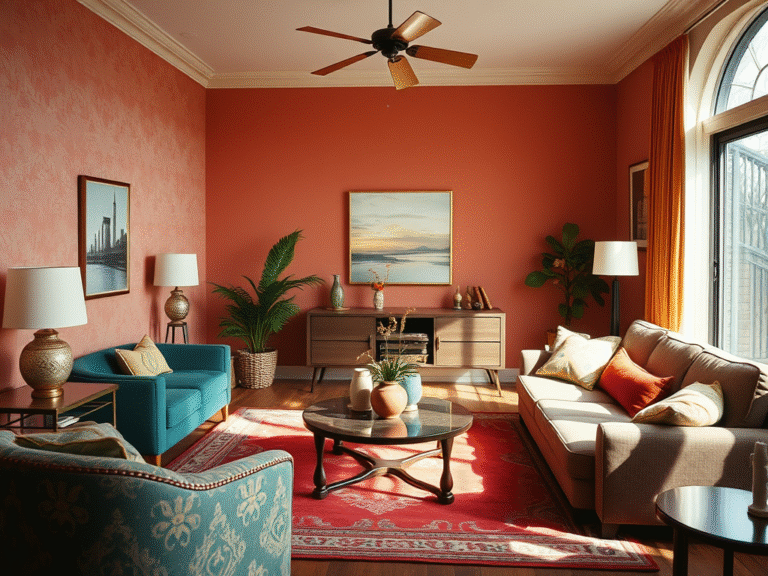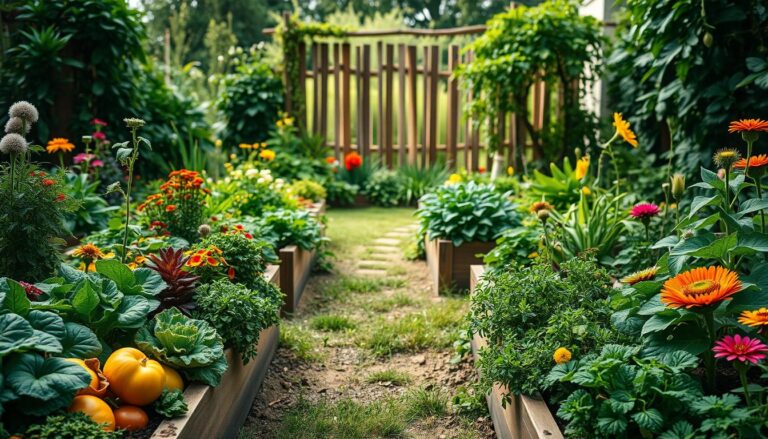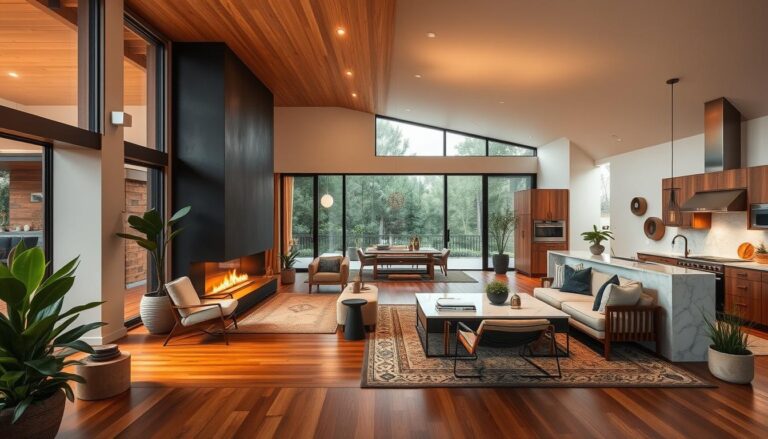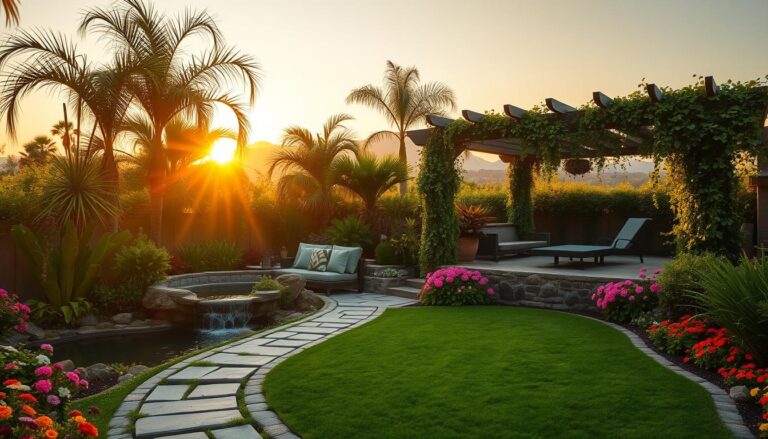Small-Space Garden Magic: Grow Big In Tiny Spaces
This post contains affiliate links, meaning I may receive a small commission if you make a purchase through my links, at no extra cost to you.
Imagine turning your tiny balcony, windowsill, or patio into a lush garden. You don’t need a big yard to enjoy gardening. With creativity and the right techniques, you can grow a thriving garden in even the smallest spaces.
You can make any small area vibrant with the right plants and space-saving methods. This article will show you how, with practical tips and inspiration to start.
By the end of this article, you’ll know how to create your own tiny space garden. You’ll enjoy the beauty and bounty of nature right at your doorstep.
Key Takeaways
- Discover how to maximize your tiny space for gardening.
- Learn about the best plants for small-space gardens.
- Explore space-efficient gardening techniques.
- Get tips on small gardening landscaping ideas.
- Understand how to maintain your small-space garden.
Understanding Small-Space Gardening
Starting your small-space gardening journey is exciting. It’s not just about growing plants in small areas. It’s about creating a thriving ecosystem that brings many benefits.
Gardening in small spaces is rewarding. It lets you grow your own food and adds beauty to your area. Gardening also helps reduce stress and improves your mental health.
The Benefits of Gardening in Small Areas
Gardening in small areas has many advantages. It lets you use your space well, turning even small areas into small magical garden spaces. You can grow herbs, vegetables, and flowers, depending on your preferences and the space you have.
Some key benefits include:
- Increased food production, even in tiny areas
- Aesthetic appeal, turning your space into tiny garden treasures
- Opportunity for stress relief and mental well-being
- Potential for increased biodiversity in urban areas
To show the potential of small-space gardening, here’s a table of common plants for small gardens and their benefits:
| Plant Type | Benefits | Space Requirement |
|---|---|---|
| Herbs (Basil, Mint) | Culinary, aromatic | Small pots or containers |
| Leafy Greens (Lettuce, Spinach) | Nutritional, easy to grow | Shallow containers or vertical planters |
| Flowering Plants (Marigold, Petunia) | Aesthetic, attracts pollinators | Containers or hanging baskets |
Common Challenges in Small Spaces
Small-space gardening is rewarding but has challenges. Limited space means plants need careful selection and management. Issues like limited sunlight, soil quality, and pest management are more noticeable in small gardens.
To overcome these challenges, knowing your plants’ needs is key. Use containers with good drainage, choose plants for the light you have, and manage pests well.
By understanding these challenges, you can enjoy the many rewards of small-space gardening.
Best Plants for Small Gardens
Choosing the right plants is key for a small garden. You can pick compact and productive plants. This is true whether you want to grow food in small spaces or add color.
Edible Options for Limited Spaces
Growing your own food in a small garden is rewarding. You can grow many compact vegetables in small areas. Some great options are:
- Leafy greens like lettuce and spinach
- Cherry tomatoes and other compact tomato varieties
- Herbs such as basil and mint
- Radishes and other root vegetables
These plants are ideal for a small garden vegetable patch. They give you fresh produce all season.

Flowering Plants to Brighten Tiny Areas
Flowering plants also brighten up small gardens. Some top picks are:
- Petunias and other spreading flowers
- Compact rose varieties
- Marigolds and zinnias
- Herbs with flowers, such as chamomile
These plants make your micro garden stunning. They turn it into a lovely outdoor spot.
By mixing edible and flowering plants, you create a lively micro garden. It meets your needs and beautifies your space.
Container Gardening Essentials
You can turn even the smallest urban areas into lush gardens with the right techniques. Container gardening is perfect for urban living where traditional gardening is hard. It lets you use balcony gardens, hanging baskets, and wall-mounted planters well.
Choosing the Right Containers
When picking containers, think about size, material, and drainage.
- Size: Make sure the container is big enough for the plant’s roots.
- Material: Pick materials that last outdoors, like terracotta, plastic, or wood.
- Drainage: Containers need holes for water to drain to avoid soggy soil.

Soil and Drainage Tips
Good soil and drainage are key for your container garden’s health. Use a top-notch potting mix that holds moisture but drains excess water. Adding perlite or sand helps with drainage.
| Container Type | Ideal Soil Mix | Drainage Tips |
|---|---|---|
| Hanging Baskets | Lightweight potting mix | Add perlite for extra drainage |
| Wall-Mounted Planters | Mix with compost for nutrients | Ensure planters have drainage holes |
| Balcony Containers | Standard potting mix | Elevate containers for better drainage |
By using these container gardening tips, you can make a thriving garden in even the smallest urban spaces.
Vertical Gardening Techniques
Turn your small urban area into a green paradise with vertical gardening. Use walls, trellises, and other supports to grow more plants. This way, you don’t take up too much floor space.
Vertical gardening is more than just pretty. It’s a smart way to grow many plants in tight spots. It’s perfect for rooftop gardens, using old furniture, or making the most of small spaces.
Wall Planters: Maximize Your Space
Wall planters are great for adding plants to your space. They come in many styles, from simple to complex. Think about the weight, material, and how they’ll attach to the wall when picking planters.
Key considerations for wall planters include:
- Material and durability
- Weight capacity and distribution
- Watering and drainage systems
- Aesthetic appeal and design flexibility
For outdoor walls, like a rooftop garden, make sure planters can handle weather. They should also be securely attached to resist wind and other elements.

Using Trellises and Arches
Trellises and arches are both useful and beautiful. They support climbing plants, saving space and looking good while doing it.
Benefits of using trellises and arches include:
- Supporting climbing plants like peas, beans, and flowering vines
- Creating a sense of depth and layering in small gardens
- Adding architectural interest to your garden design
- Helping to define different areas within a larger garden space
When picking trellises and arches, think about the material, size, and style. Make sure they fit your garden’s look and support the plants you want to grow.
Indoor Small-Space Gardening
You don’t need a big backyard to enjoy gardening. Indoor small-space gardening is a great option. With some planning and the right choices, you can bring gardening joy into your home.
Indoor gardening has many benefits. It purifies the air and makes your home look better. But, it needs careful thought, especially about light.
Light Considerations for Indoor Plants
Light is key for plant growth, including indoor plants. First, check your home’s light. Different plants need different light levels, from low to bright.
Look at where you’ll put your plants during the day. East- or west-facing windows offer gentle, indirect light, perfect for plants that like partial shade. South-facing windows get direct sunlight, great for plants that love bright light.
Best Indoor Plants for Small Spaces
After checking your light, pick plants that fit. For low light, try Chinese Evergreen or Pothos. These plants do well in low light and are easy to care for.
In brighter spots, Spider Plants or Peace Lilies are good choices. They handle bright light well and add beauty to your garden.
Herbs like Basil or Mint are also great for small spaces. They’re good for cooking and make your home smell fresh.
- Chinese Evergreen
- Pothos
- Spider Plants
- Peace Lilies
- Basil
- Mint
By picking the right plants for your space and knowing their light needs, you can make a thriving indoor garden. It will add joy and freshness to your home.
Succulents and Cacti: Low-Maintenance Choices
Succulents and cacti are great for small spaces. They need little care and can grow well in many conditions. This makes them perfect for those who are new to gardening or are busy.
These plants can store water, so they don’t need much water. They come in many shapes, sizes, and colors. This lets you get creative with your arrangements.
Care Tips for Succulents
To keep your succulents healthy, give them enough sunlight. Use soil that drains well to avoid root rot. Don’t overwater; let the soil dry out between waterings.
Some popular succulent species for small spaces include Aloe Vera, Echeveria, and Crassula. These plants are easy to care for and add greenery to your space.
Creating Stunning Arrangements
You can arrange succulents and cacti in many creative ways. Use green wall planters or terrariums to save space and look good.
Try mixing succulents with other plants or decorations like rocks. For a modern look, pair them with artificial grass or a green cover in a planter.

Play with different shapes, textures, and colors. This will help you create a display that shows off your style.
Companion Planting in Limited Spaces
You can make your small garden healthier and more productive with companion planting. This method pairs plants that help each other grow, fight pests, and taste better. By picking the right partners, your garden will thrive in any small space.
Advantages of Companion Gardening
Companion planting is great for gardeners with little space. It offers many benefits, including:
- Improved Growth: Plants like marigolds and basil help nearby plants grow better.
- Pest Control: Garlic and chives keep pests away, saving you from using harmful chemicals.
- Enhanced Flavor: Pairing plants, like basil with tomatoes, can make your food taste better.

Effective Pairings for Small Gardens
Choosing the right plants to grow together is key in small gardens. Here are some good pairs to try:
- Tomatoes and Basil: This duo makes tomatoes taste better and keeps pests away.
- Cucumbers and Dill: Dill fights off aphids and other pests that bother cucumbers.
- Carrots and Sage: Sage keeps carrot flies away, protecting your carrots.
By using companion planting in your small garden, you can make it more robust and fruitful. Think about using an archway or trellis to support climbing plants. With some planning, your small garden can yield a lot of delicious food.
Gardening Tools for Small Spaces
Starting a garden in a small area requires the right tools. The right equipment helps you grow more with less effort.
Essential Tools for Every Small-Space Gardener
Choosing the right tools is key to a great gardening experience. Here are some must-haves:
- Compact Gardening Tools: Find tools made for small spaces, like foldable rakes and trowels with comfy handles.
- Watering Cans or Watering Globes: These tools help water your plants efficiently, saving water and ensuring they get enough moisture.
- Soil Test Kits: Knowing your soil’s pH and nutrient levels is vital for healthy plants.

Organizing Your Small Gardening Area
A tidy garden is not just pretty; it also saves time and reduces stress. Here’s how to keep your space organized:
- Use Vertical Space: Hang your tools on a wall or the back of a door with hooks or a pegboard.
- Invest in Storage Containers: Use bins or baskets for seeds, fertilizers, and other supplies.
- Label Everything: Labels make it easy to find what you need in your garden.
With these tips, you’ll enjoy a more productive and fun gardening experience in your small space.
Maximizing Vertical Space
Gardening in small spaces needs creativity. One key strategy is to use vertical space. This way, you can plant more in the same area.
Maximizing vertical space lets you grow more plants and decorate your garden or indoor area. It involves using tools and techniques to use every inch of space.
Creating Layers with Plant Stands
Plant stands are great for using vertical space. They come in many designs for indoor and outdoor use. By layering plants on stands, you can show off many plants in a small area.
When picking plant stands, think about the material, size, and how easy they are to move. You want them to be strong, the right size for your plants, and easy to shift. This lets you change your garden layout as you like or as the seasons change.

Utilizing Shelving for Plant Displays
Shelving is another smart way to use vertical space. Shelves can be wall-mounted or freestanding, offering lots of room for plants. Make sure the shelves can hold the weight of your plants and are securely fixed to avoid accidents.
Shelving lets you create a tiered plant display. This not only saves space but also looks good. Mixing different plants on your shelves adds texture and color, making your space more beautiful.
To make the most of your shelves, mix trailing plants that spill over and upright plants that grow upwards. This mix creates a lively display that catches the eye and adds interest.
Seasonal Gardening in Small Spaces
To get the most out of your small garden, learning about seasonal gardening is key. It helps you get more from your garden and keep it looking great all year. By changing your gardening ways with the seasons, you can have a steady supply of fresh plants.
Creating a planting schedule is crucial for small gardens. This means planning when to plant different crops for the best season. For example, in spring, plant cool-season crops like lettuce and peas. Summer is for warm-season crops like tomatoes and peppers.
Planting Schedules for Small Gardens
Creating a planting schedule for your small garden means knowing your local climate. Look at frost dates, growing seasons, and temperature changes. This helps you plan for the best growing times.
In short growing seasons, start seeds indoors before the last frost. In longer seasons, you can plant them directly outside.
| Season | Crops to Plant | Tips |
|---|---|---|
| Spring | Lettuce, Spinach, Peas, Radishes | Plant cool-season crops as soon as the soil can be worked in the spring. |
| Summer | Tomatoes, Peppers, Eggplants, Cucumbers | Warm-season crops thrive in the heat of summer. Ensure adequate watering. |
| Fall | Broccoli, Cauliflower, Kale, Carrots | Start planting cool-season crops again in late summer for a fall harvest. |
| Winter | Kale, Spinach, Brussels Sprouts, Herbs | In mild winter areas, continue to harvest cool-season crops. In colder areas, use protective measures like row covers. |
Best Seasonal Crops to Grow
Picking the right crops for each season is key for a small garden. Some crops do better in cooler spring and fall, while others love the summer heat.
Spring Crops: Lettuce, spinach, peas, and radishes are great for spring. They grow well in cooler weather and can be picked before summer.
Summer Crops: Tomatoes, peppers, and eggplants are top choices for summer. They need warm weather and a long growing season to grow well.
For a visually appealing addition to your garden, consider incorporating flowering plants that complement your seasonal crops.

By using seasonal gardening, you can have a diverse and productive garden, even in the smallest spaces. Whether you grow food or flowers, adapting to the seasons will help you make the most of your garden.
Designing Your Small-Space Garden
To make the most of your small garden, a good design is key. A well-designed garden is not just pretty. It also makes your space more functional and cozy.

Choosing a Theme and Color Palate
Picking a theme and color scheme is the first step. Your theme could be simple, like a color scheme, or more complex, like a Japanese Zen garden or a tropical oasis.
Think about your surroundings when picking your theme and colors. Your garden should match your home’s architecture and the area around it.
- Stick to a few core colors for a cohesive look.
- Think about the plants’ mature colors, not just their initial ones.
- Use different foliage textures and flower shapes for depth.
Creating Zones for Functionality
In a small garden, different zones can make it more useful. You might have a dining area, a spot for relaxation, and a section for herbs or veggies.
Think about how you use your garden. If you like to entertain, a dining or seating area is important. For those who cook a lot, a herb zone is handy.
To set up zones well:
- Use planters, trellises, or screens to mark different areas.
- Plan the flow of traffic through your garden.
- Make sure each zone has its own vibe but fits the overall theme.
Eco-Friendly Practices for Small Gardens
When you garden in a small space, using eco-friendly methods is key. These practices help your garden grow well and protect the environment. They make gardening a fun and green activity.
Reducing Waste with Sustainable Care
Using natural products is a big part of sustainable gardening. You can feed your plants with compost, manure tea, or worm casting. This method cuts down on chemicals and makes the soil better.
Composting in Small Spaces
Composting turns old waste into a soil booster. Even with little room, you can compost using small bins or worm composting. It’s great for the soil and helps the environment.
By choosing eco-friendly gardening, your small garden can be both lovely and green. Simple steps like using natural care and composting help. They let you enjoy gardening while helping the planet.
FAQ
What is small-space gardening, and how can it benefit me?
Small-space gardening means growing plants in small areas like balconies or courtyards. It brings calm, boosts food production, and beautifies your space.
How do I choose the right plants for my small garden?
Pick plants based on sunlight, climate, and soil type. Compact veggies, flowers, and succulents work well in small gardens.
What are some effective vertical gardening techniques?
Use wall planters, trellises, and arches for vertical gardens. They save space and add beauty.
How can I ensure proper soil and drainage in my container garden?
Choose containers with holes and use a draining potting mix. Add compost to improve soil.
What are some benefits of companion planting in small gardens?
Companion planting boosts growth, fights pests, and enhances gardening. Pairing plants like marigolds with tomatoes creates a balanced garden.
How can I maximize my vertical space for gardening?
Employ plant stands, shelving, and wall planters for layers. This maximizes space and adds beauty.
What are some eco-friendly practices I can adopt in my small garden?
Use compost, reduce water waste, and choose drought-tolerant plants. Composting in small spaces is eco-friendly.
How can I design a functional and beautiful small-space garden?
Pick a theme and color palette, and create zones. Mix edible and flowering plants for beauty and function.
What are some tips for growing a lot of vegetables in a small space?
Use vertical gardening, companion planting, and succession planting. Choose compact varieties and use space wisely.
How can I care for succulents and cacti in my small garden?
Succulents and cacti need little water and good drainage. Ensure sunlight and fertilize sparingly during growth.







